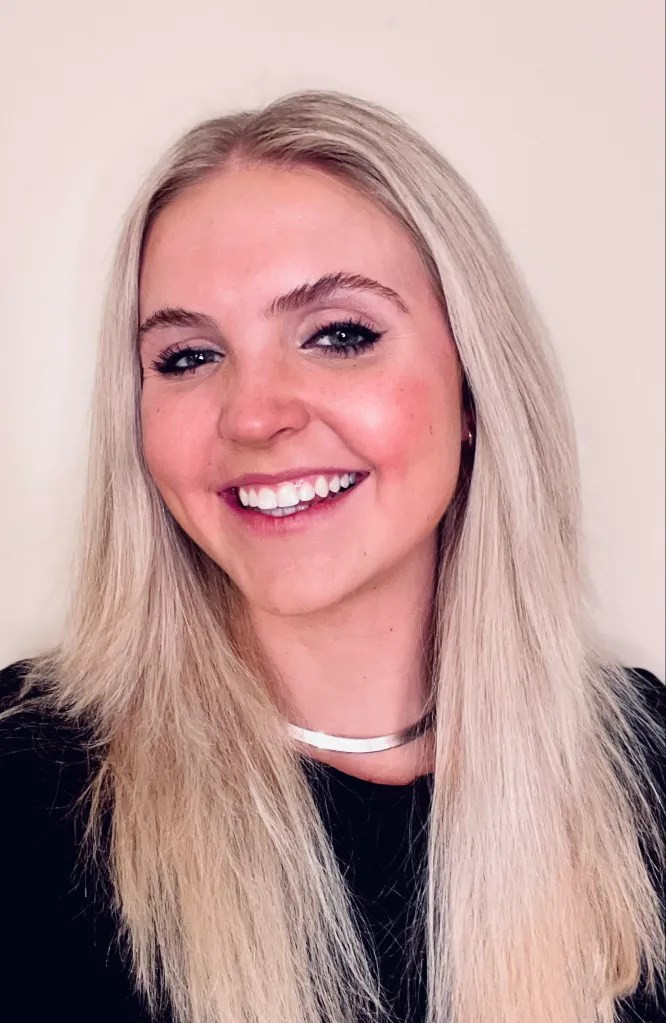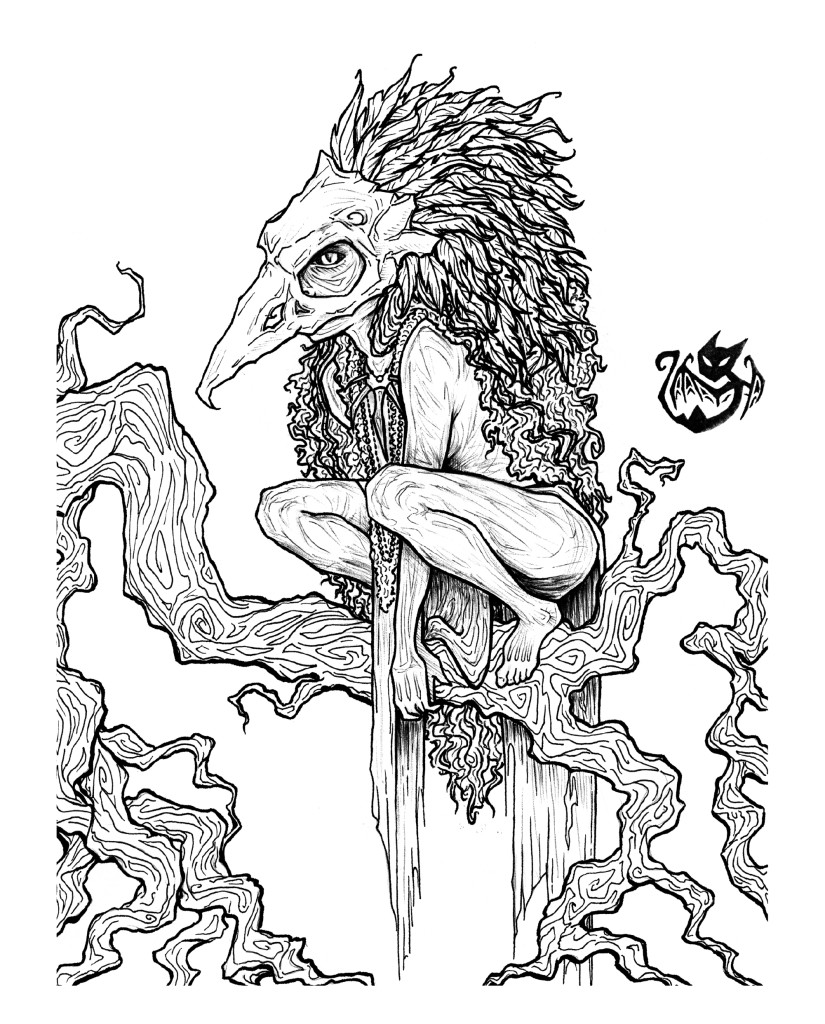Natalia Andrus, the talent behind Eerie Ink, is a versatile freelance artist celebrated for her captivating work in both digital and traditional mediums. Her distinctive style, particularly her black ink drawings, caught the eye of James Morehead, leading to a fruitful collaboration for his book, “The Plague Doctor”. This article delves into an insightful interview with Natalia, exploring her artistic journey, her unique approach to ink art, and how she masterfully translated the essence of poetry into striking visual representations of plague doctors and other fantastical themes. Discover the magic behind Natalia’s Plague Doctor Art and her broader portfolio, revealing the intricate process and inspiration that fuels her creative vision.
James Morehead: Your portfolio showcases a remarkable range of vivid imagery across ink pen, acrylic, and digital mediums. What initially sparked your passion for visual arts?
 Natalia Andrus headshot, a portrait of the artist with dark hair and a thoughtful expression, showcasing her creative persona
Natalia Andrus headshot, a portrait of the artist with dark hair and a thoughtful expression, showcasing her creative persona
Natalia Andrus: “My artistic journey began in my early years. The positive feedback and encouragement I received from classmates were pivotal. Moreover, I was fortunate to have artistic role models within my family. Both of my great-grandparents were artists, and growing up surrounded by their artwork profoundly influenced me. My current focus on ink artwork was actually inspired by Inktober, a challenge where artists create ink-based pieces following daily prompts. This initiative became the catalyst for my exploration and development of ink art.”
James: Observing the evolution of your skill through your Instagram account is fascinating. A very distinct style has emerged. How would you define your artistic style, encompassing both your ink and non-ink pieces?
Natalia: “I would characterize my style as ‘hard-cut’. I’m drawn to lines that possess a deliberate imperfection, lacking perfect symmetry or parallelism, as I believe this adds a crucial dimension to my pieces. Beyond that, my style is deeply rooted in creativity and imagination. I’m not inclined towards direct representations; instead, I enjoy synthesizing diverse elements to construct something entirely novel. For me, art is fundamentally about innovation and offering personal interpretations.”
James: You adeptly navigate various media, from traditional to digital. How do you determine the most suitable medium for a particular subject? Is your process idea-driven, where you select the medium afterward, or medium-driven, where the medium inspires the art itself?
Natalia: “Most often, my starting point is a specific medium. For example, within my Eerie Ink series, I begin with a prompt and a predetermined commitment to the Eerie Ink style. The prompts themselves are chosen to resonate with this style, emphasizing an eerie aesthetic. This approach has been consistently effective, particularly with my digital art. Given the color palette in my digital work, I typically aim for more expressive and interpretive outcomes. The stylistic variance between my Eerie Ink, digital, and even pencil illustrations is quite significant. In essence, medium selection usually precedes subject development in my creative process.”
James: Fantasy and animated characters appear to be a recurring theme in your portfolio. What draws you to these subjects?
 Eerie Ink style artwork titled Feral Creature, depicting a stylized, dark fantasy creature with intricate ink line work
Eerie Ink style artwork titled Feral Creature, depicting a stylized, dark fantasy creature with intricate ink line work
Natalia: “My fascination with fantastical and animated characters stems from my childhood immersion in fantasy narratives. Growing up, I was captivated by these stories and felt compelled to create my own characters, using images to bring their stories to life.”
James: When you design a character, do you envision an unseen backstory for them, enriching the artwork with a hidden narrative?
Natalia: “Absolutely! The depth of the backstory varies, but it’s a detail I enjoy adding as it enhances the artwork’s intrigue and enjoyment. Even without a specific story, I aim to infuse emotion into each character. I imagine my illustrations as scenes from a larger narrative, considering how compelling and engaging they would be in a real-life context. My goal is to create art that captures attention and invites personal connection.”
James: As a poet translating images into verse, can you describe your process of developing a piece from a preliminary pencil sketch to a finished artwork, especially concerning your illustrations for ‘The Plague Doctor’ book?
Natalia: “I deeply value the pencil sketching phase for its liberating creative potential. As you observed during our book project, I often introduce changes between the sketch and the final piece. In some works, I focus detailed sketching on a specific element, contrasting it with a looser background. In the inking stage, the pen often seems to guide itself, leading to spontaneous decisions. This instinctual aspect is what I find most appealing.
“Sketching is crucial for initiating creativity and allowing me to transfer initial ideas to paper, experimenting with lines. My style incorporates many exaggerated lines, and directly inking would likely inhibit the relaxed and enjoyable nature of the process. The transformation during inking, especially filling in black areas and creating contrast, is always exciting. The final outcome often holds surprises even for me.”
James: So, the pencil sketch acts as a safety net, mitigating the pressure of ink’s permanence?
Natalia: “Precisely. However, I also appreciate the inherent finality of ink, which is why I intentionally maintain a degree of looseness. It encourages self-trust and reduces overthinking.”
James: I first encountered your Eerie Ink black and white pieces at SiliCon in San Jose. The detail, shading, and paint-like texture achieved with ink pens are truly exceptional. How did you cultivate this technique?
 Eerie Ink artwork Dangerous Waters, showcasing intricate ink detail and a dynamic, fluid style reminiscent of dark fantasy art
Eerie Ink artwork Dangerous Waters, showcasing intricate ink detail and a dynamic, fluid style reminiscent of dark fantasy art
Natalia: “Thank you! This technique is primarily the result of consistent practice. My early participation in Inktober, while not yet the fully formed Eerie Ink style, was its precursor. My mentor, Kip Rasmussen, recognized potential in my work and encouraged its further development. My first dedicated Eerie Ink piece resonated deeply with me, and from there, the style evolved. Inktober prompts were initially inspiring, but I soon began creating my own, leading to unique interpretations and increased efficiency and confidence with ink. Continuous creation, anatomical study, improved thumbnail sketching, and character-driven storytelling have been key to my progress.”
James: For ‘The Plague Doctor’, you created three commissioned pieces inspired by poems and photographs. Could you elaborate on your process of transforming these starting points into original artworks that complement the poetry yet remain distinctly yours?
Natalia: “My aim was to capture the essence of your poems while infusing my own creative perspective. For the plague doctor art piece, I noted the female representation and incorporated the ‘tendrils of fog’ from your poem. I synthesized specific details, like the plague doctor’s attire, with your reference photos and the poem’s themes.
“In ‘Memoir of the Automaton’, I concentrated on the facial structure and emerging elements, aligning them with the poem’s description of the automaton’s fingers.
“For ‘Humerus, Tibia, and Laughing Skull’, I was inspired by paint drips and bulldog bones, recognizing their illustrative potential. My core approach was to extract elements from the photos and poems, merge them, and create artwork that honored the source material’s originality while offering a personal interpretation for readers to connect with the poetry.”
James: Your ink art significantly enhances the book, especially the Plague Doctor piece as the opening image. What are the advantages and disadvantages of ink art versus digital art, given digital art’s prevalence?
Natalia: “Ink art’s boldness is a major advantage. Original ink pieces have a tangible presence that digital or print reproductions can’t fully replicate. The texture of lines on paper and details like white paint pen highlights are lost in digital formats.
“A disadvantage is the lack of absolute sharpness in ink lines, which, while contributing to traditional art’s charm, can be limiting for fine details. Mistakes in ink are also less forgiving and more time-consuming to correct than in digital art, which offers the convenience of ‘undo’. However, the challenges inherent in ink art ultimately contribute to a more rewarding outcome, in my opinion.”
James: The originals’ tactile quality and hand-drawn nuances are indeed captivating. For those interested in commissioning a piece, what advice do you have for ensuring a successful collaboration?
Natalia: “James, your approach to commissioning work is exemplary. Providing the poem and a reference image while granting creative freedom is ideal for me. Ambiguity or overly specific, unclear instructions can lead to complications. I always seek clarification when needed, but clients should strive for clear communication of their vision. Creative freedom often yields the best results. For very specific requests, open discussion and adjustments are key to aligning the final piece with the client’s expectations.
“Starting with one or two reference images is excellent. Too many can be overwhelming and impractical to incorporate fully. Three or four references, combined with clear expectations, strike the right balance for a successful commission.”
James: I aimed to provide a starting point and then allow your artistic interpretation to flourish. For artists aspiring to a career in art, what have you learned about selling your art, especially at the beginning of your journey?
 Natalia Andrus showcasing her Eerie Ink art at a convention, engaging with attendees and displaying her detailed ink drawings
Natalia Andrus showcasing her Eerie Ink art at a convention, engaging with attendees and displaying her detailed ink drawings
Natalia: “Building supportive relationships is crucial. This involves networking, client interaction, and flexibility in negotiations. For marketing, establishing a social media presence and defining your niche are essential – hence my separate Instagram accounts. Clarity about your style and offerings is vital. Also, ensure easy client access for contact and purchases through a website or similar platform.
“While Instagram and TikTok are useful for marketing, in-person events like SiliCon and Salt Lake FanX have been most effective for sales and networking. These events provide direct engagement and broad reach. Embrace every opportunity, even if inconvenient initially. Prioritize building connections and maintaining high artistic standards. This approach sets a positive trajectory for both your art and client relationships.”
🔗 More Viewless Wings Interviews
